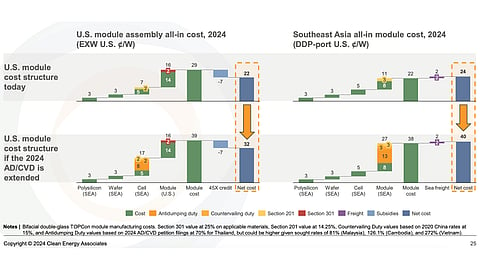

A new CEA report, commissioned by ACORE, explores the potential impact of AD/CVD imposition on the US solar market
Module prices will increase significantly in such an event, hampering solar panel supply and installations
It will also negatively impact the country’s buildup of solar cell and module production capacity
Imposition of new, unpredictable anti-dumping/countervailing duties (AD/CVD) on solar cells and modules from Southeast Asia will likely increase costs to a level that will significantly restrict solar supply and installations in the otherwise healthy US solar sector, says a new Clean Energy Associates (CEA) report.
Commissioned by the American Council on Renewable Energy (ACORE), the report expects the price of US-made modules to go up by $0.10/W and that of imported modules by $0.15/W in the event of the AD/CVD imposition (see US ITC To Continue AD/CVD Investigations Into Solar Imports).
In fact, the report claims the 2024 AD/CVD filing alone has caused the US module prices to increase. The impact is, at present, less volatile than the Auxin Solar case thanks to existing inventory.
Nonetheless, the CEA warns that many buyers may delay new procurement until the market settles and a preliminary determination is out. Most suppliers are also preparing to halt deliveries. If the duties are manageable, the shipments may continue.
Reflecting on the pricing disparity since the imposition of AD/CVD duties in 2012, the writers claim that the US buyers have either paid additional duties for imported modules from China or shifted procurement to other countries with higher production costs. Hence, the module pricing paid by the US and the global average module price paid by many peer countries differ due to the trade policies.
This pricing disparity, along with other headwinds including domestic factors and trade restrictions, could seriously hinder the country’s solar deployment progress fear the writers. By other headwinds, the report refers to 25% to 50% Section 301 tariffs for many PV components, and Section 201 tariffs on bifacial module imports that the report writers claim have increased costs for importers by over 14% (see Bifacial Solar Panels Lose Section 201 Tariff Protection).
Additionally, the restrictions on imported cells will likely harm American module manufacturers as the country has no significant cell capacity of its own. According to the analysts, the US could have a cumulative solar module production capacity of 60 GW by 2026 up from 31 GW in 2024, while cell capacity can grow to 12 GW by 2028, up from 1 GW in 2024.
However, the Inflation Reduction Act (IRA) has led to a wave of US manufacturing announcements across the value chain, including 131 GW of modules, 87 GW of c-Si cells, 21 GW of wafers, and 28 GW of polysilicon by 2030.
“Injecting uncertainty into the market slows economic growth and the good-paying jobs clean energy creates, undermines US climate objectives, and will inevitably raise energy costs for American families,” said ACORE President and CEO Ray Long. “This is not an appropriate course of action and could unintentionally cede US leadership in the solar industry to other countries.”
The complete CEA report titled Potential Impacts of the 2024 Antidumping and Countervailing Duties on the US Solar Industry is available on the ACORE website.
